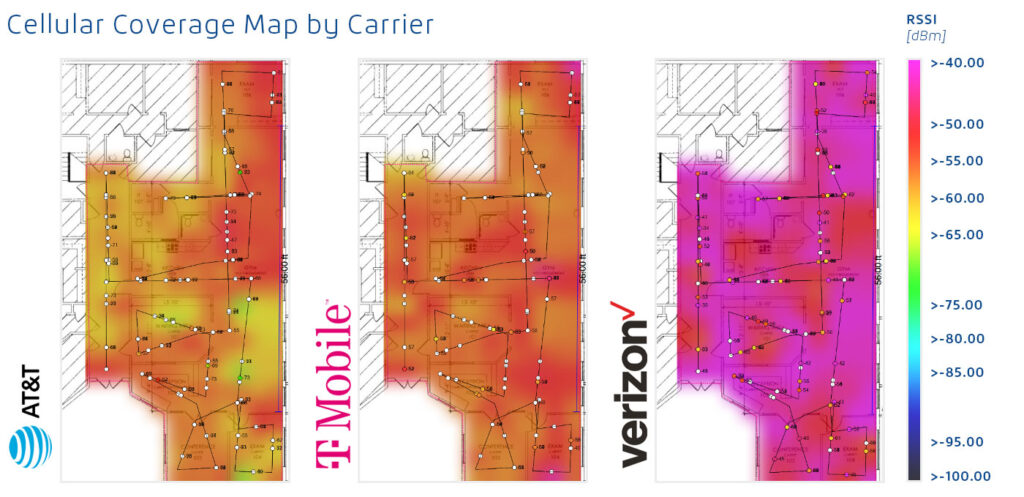Consumers and businesses alike depend on smartphones – which depend on signals from cellular carriers (also called mobile network operators, or MNOs). This presents problems in many healthcare facilities where stakes are high yet signals are often compromised.
One healthcare network turned to Velaspan for help.
The Challenge
There’s a good chance you’ve experienced it: Weak cellular signals in healthcare settings. This is common – the result of factors including facilities’ large sizes (exacerbated when extended across multiple floors) on top of standard cellular variables like proximity to cellular towers.
Further complicating matters is the fact that signal strength varies from carrier to carrier. “I have T-Mobile and can’t get a signal in the stairwell” or “AT&T only gets one bar in the emergency room” are common healthcare refrains. Because they’re anecdotal, there’s no way for leadership to qualify or quantify them.
It’s what a major northeastern healthcare network was facing when they reached out to Velaspan in 2021. Inconsistent cellular signals had gained the attention of leadership when a doctor was unable to make a smartphone call under their roof in a critical patient moment.
We explained how Velaspan could help.
Cellular Coverage Assessments
Because cellular signals are controlled by mobile network operators, no one except MNOs themselves – not Velaspan, not our competitors, not businesses experiencing issues – can strengthen a carrier’s cellular signal at its source.
However, there are options for managing and even optimizing cellular signals. They all start with a cellular coverage assessment.
Driven by comprehensive cellular mapping, cellular coverage assessments offer a detailed look at a facility’s coverage intricacies. They show exactly where each major carrier’s signal is and isn’t reaching, to what extent, and other key performance indicators like signal quality and interference. The deliverable here is knowledge.
Our healthcare client agreed that a cellular coverage assessment was what they needed to understand cellular in their space. Floor to floor, campus-wide, the assessment was carried out by a single Velaspan engineer without interrupting healthcare operations. Coverage data on Verizon, AT&T, and T-Mobile was collected in one fell swoop and outlined in a detailed report complete with floor plans and imagery.

What’s Next?
Findings of a cellular coverage assessment can help healthcare networks and other organizations in a number of ways:
In-house, they can be used to guide behavior and manage expectations. For example, our healthcare client now knows with certainty that T-Mobile signals do not, in fact, reach stairwells; they can make staff, patients, and visitors aware. Some Velaspan clients take this further, using cellular coverage assessments to choose the best carrier for their own internal and company-issued smartphones and devices. Cellular coverage assessments also provide a baseline against which future assessments can be compared – helpful if coverage changes abruptly, which sometimes happens when networks are re-engineered by carriers.
The wealth of information within coverage assessment findings can also be used to make a business case for or against DAS. Short for distributed antenna systems, these privately-owned mobile networks extend a carrier’s cellular signal throughout a space. DAS networks are significant investments and carrier-specific, with each added carrier dramatically increasing total deployment costs. Understanding the nuance of coverage from carrier to carrier is therefore essential to DAS-related decision-making, planning, and overall investment.
Last but not least, some larger Velaspan clients actually present coverage assessment findings to the cellular carriers. With proof in hand of coverage deficiencies, they can ask the carrier to consider re-engineering a network to improve the identified weakness. There’s no guarantee a carrier will acquiesce; however, some large organizations have successfully leveraged their influence in this way.
Outcome
Armed with Velaspan’s coverage assessment report, today our healthcare client is engaged in conversations with the two problematic carriers. They’re discussing the possibility of changes on the carriers’ end to improve cellular connectivity across their two campuses. Our healthcare client has also communicated the assessment’s findings internally, bringing an end to cellular service hearsay. All in all, it’s a huge step forward in the quest to avoid cellular-induced pitfalls and keep users connected hospital-wide.
If you're interested in seeing the type of results we can achieve for your business, don't hesitate to reach out to us for a consultation.
Let’s Discuss
